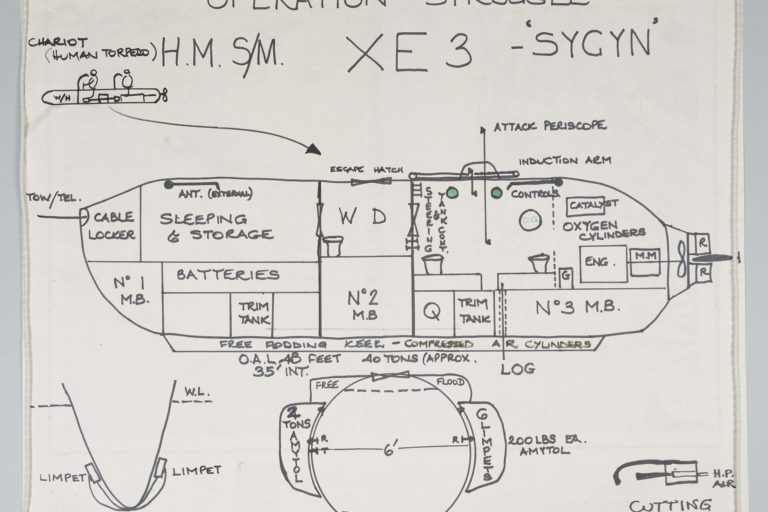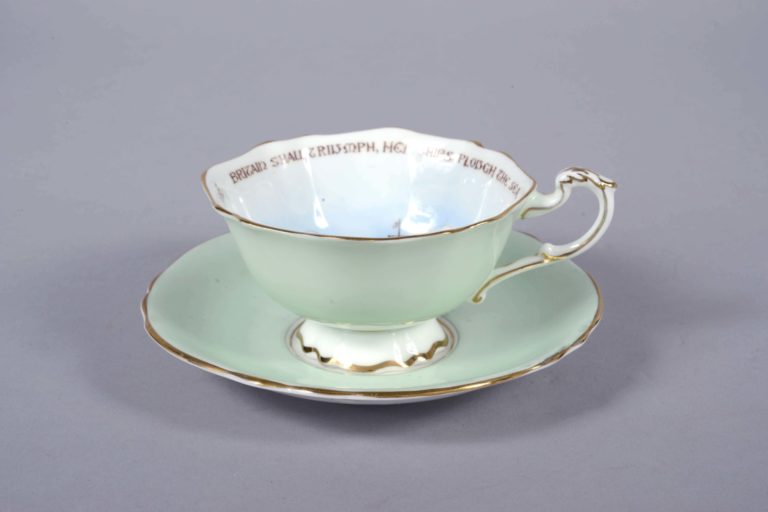
History:
Charles Palmer was the driving force behind the formation of a volunteer reserve in New Zealand, and in 1925 the Auckland Division of the RNVR (NZ) was formed. It was followed by divisions formed in Wellington, Christchurch, and Dunedin in 1928. The Wellington Division of the RNVR (NZ) was formed on 12 March 1928. Commander Wybrants Olphert was posted as its first commanding officer. The new unit comprised of two officers and 120 ratings divided into two companies. Commander Olphert remained as commanding officer until 1938 when Captain F.E. Taylor replaced him.
The first home of the division was the top floor of the National Diary Association building on Thorndon Quay. In 1931, when the division expanded to 19 officers and 180 ratings, a new base was found on the the first floor of the Public Works Department workshop building on Hinemoa Street.
At this time, the volunteers were sorted into various branches for training. For example, the seaman branch received seamanship instruction, rifle and gun drill, rifle shooting, boat work, and rowing. Ratings who were promoted to Able Seamen progressed to either gunnery or minesweeping branches. Signalmen were given a short course in rifle drill and rope work, then trained in semaphore by mechanical arms and flags, Morse code by flag, lantern and sound. Sea training was carried out in the minesweeper HMS Wakakura whose bell is kept today by Olphert. The vessel was assigned to Wellington from October to December each year, as part of a rotation policy amongst the four divisions. Exercises in gunnery, minesweeping and seamanship were carried out in the Marlborough Sounds.
Second World War
The outbreak of war suspended Naval Reserve activity. Volunteers were called up for hostility only duty with the New Zealand Division of the Royal Navy, or sent to the Royal Navy. During the war over 50 percent of men serving in the Royal Navy were Volunteer Reserve. RNVR officers took command of 2,000 warships including 600 minesweepers, MTBs, MLs and trawlers. One of the most significant officers to come from the Wellington Division was Lieutenant Commander G.J. Macdonald. He had joined the RNVR (NZ) in 1938, and went overseas as an Able Seaman to the United Kingdom was part of the Scheme B recruitment scheme. He was commissioned into service with the Coastal Forces and commanded an MTB and finished the war in command of a flotilla of MTBs. For his services he was awarded a DSO and a DSC with two Bars. He is the most decorated New Zealand naval officer.
Lieutenant Peter Phipps joined the Canterbury Division but transferred to Wellington in 1939. He along with a number of RNVR (NZ) officers were sent to the United Kingdom to command minesweepers serving with the Coastal Forces. He was awarded the DSC for his services in minesweeping. In 1943, he was the commanding officer of the MS/ASW vessel HMNZS Moa, which sank the Japanese submarine I-1 alongside HMNZS Kiwi. He was awarded the Bar to his DSC and the US Navy Cross. Post war he commanded the shore establishment HMNZS Philomel, and was Executive Officer of HMNZS Bellona. He also commissioned HMNZS Royalist into RNZN service. He ended his career as the first Chief of Defence in 1966.
Sixteen Wellington RNVR men were lost in December 1941, while serving in HMS Neptune. Two other men were lost as gunners serving in the DEMS RMS Rotorua that was sunk in 1940. Thirty-one men from Wellington RNVR lost their lives serving during the war.
Post War
The Wellington Division of the Royal New Zealand Navy Volunteer Reserve was reformed in 1946. The first commanding officer was Captain F.E. Taylor who had been in command of the old RNVR formation in 1939. By the early 1950s the strength of the Division was 33 officers and 240 ratings. Captain Taylor remained as commanding officer until 1957. During this time, the cuff braid that distinguished VR officers was discontinued and standardised across all parts of the RNZN.
The introduction by the government of compulsory military training (CMT) saw the strength of the RNZNVR rise dramatically. Men who chose naval service were given fourteen weeks basic training at HMNZS Tamaki, then remained attached to their nearest Division for three years. Harbour Defence Motor Launch (HDML) P3562, which had served during the Second World War was attached to Olphert and was based at Shelly Bay. This vessel remained in service for over 24 years and was at sea an average of 100 days per year.
In 1958, compulsory military training was discontinued and the RNZNVR returned to a purely voluntary organisation with a reduction in numbers under training. In the 1960s, with the arrival of the new frigates a new training programme was set up for officers and ratings, based around service on the frigates and focused on gunnery and anti-submarine warfare. The role of the RNZNVR at this time was to train volunteers that would supplement the RNZN fleet.
In 1964, the Naval Reserve was brought under the command of Commodore Auckland after the disestablishment of the Naval Board. Following this step, men who joined the RNZNVR were allowed to join a branch based on their civilian occupation. During this time, Harbour Defence Motor Launch P3562, known as Parore, was replaced by the SDML HMNZS Manga. Once a year the SDMLs from the RNZNVR would participate in a joint exercise that formed a valuable part of seamanship training for ratings and officers. In 1968, Manga was involved in the rescue effort after the sinking of the inter-island ferry Wahine. The fleet of SDMLs was rotated between the divisions. HMNZS Kuparu was the last SDML to serve with the Division, and was decommissioned in 1984.
1970s – 1980s
In the 1970s pay restrictions were lifted, and the Wellington Division was able to give a good account of itself, despite the considerable scrutiny by the Ministry of Defence. In 1978, the RNZNVR was restructured so that the reservists were to be trained in handling small ships, and to serve in the administration of Naval Control of Shipping.
In the late 1970s and early 1980s the VR Officers and ratings worked well with the RNZN. With the addition of the four Lake-class patrol craft in 1975 to the fleet, this provided a good opportunity for sea time for the Volunteer Reserve as these vessels carried out fisheries patrols.
In 1985 four inshore patrol craft were commissioned into RNZN service. HMNZS Wakakura was assigned to Olphert. Initially there were fisheries patrols but this was discontinued following government policy changes. But the new vessels allowed a return to fleet training exercises under the new Maritime Commander New Zealand (formerly Commodore Auckland). Wakakura had a greater range and better seakeeping abilities than the SDMLs and were good vessels to carry out a broad range of seamanship training. The usefulness of the vessel was demonstrated when Wakakura helped co-ordinate the rescue operation when the Russian cruise liner Mikhail Lermontov sank in the Marlborough Sounds in 1986.
1990s to Present
Olphert has continued to change with the times especially the introduction of women to sea service. Since 1989 when women began to train alongside men, there have been women volunteers. Along with the Naval Control of Shipping the 1990s saw the focus extended to include mine countermeasures for the seagoing branches. This has been included in the VR training programme. HMNZS Wakakura was decommissioned in 2007 and presently Olphert does not have its own vessel. However with the introduction of the Project Protector patrol vessels there is again opportunity for sea training.
The Shore Establishment
The base at Hinemoa Street remained in operation until 1969. In 1970 the Ministry of Defence took over a lease of a Cadbury’s warehouse in Ghuznee Street. The ratings and officers of Olphert took six months to refurbish the building for use by the RNZNVR. This was only a temporary home as costs lead the RNZN to seek alternative quarters.
The reorganisation of the NZ Army left the Home Command Building in Buckle Street vacant, and the decision was made to relocate HMNZS Olphert to this building. The shift took place in 1978. Until 1986 the building was shared with the Defence Services Transport Pool. Again, the ratings and officers of Olphert put a lot of effort into refurbishing the building for naval use. On 31 May 2015, due to the expense of earthquake proofing the Buckle Street building, the decision was made to relocate the Wellington Division of the RNZNVR to a permanent home at 34 Waione Street, Petone. In this location the Wellington Division forms part of the Wellington Reserve Centre along with personnel from New Zealand Defence Force Recruitment.
Ship’s Badge:
The badge was originally going to be a replication of the Olphert family crest which was a dove holding an olive branch with the motto Dum Spiro Spero (While I live, I hope). The design was submitted to the College of Heralds in London who rejected it, and came up with a falcon’s claw holding an arrow rising from the sea. This was accepted and established as the official badge. This was the first unit of the RNZN to be named after a New Zealander.










